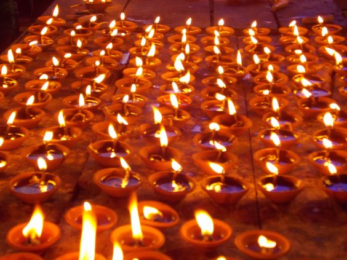The word ‘sandhi’ means ‘junction’ and ‘puja’ means worship. Sandhi puja is performed at the juncture between two periods of time – the last moments of Ashtami and the first moments of Navami during Navratri. The puja is generally performed for 48 minutes, comprising the last 24 minutes of Ashtami and the first 24 minutes of Navami, two of the most auspicious days in the Hindu calendar.
Devotees gather during this time to offer prayers and ask for divine blessings. The victory of good over evil, light over darkness, and wisdom over ignorance is symbolised by sandhi puja for Hindus. It is a moment to consider the influence of the divine and the worth of upholding one’s principles and beliefs. Devotees try to purify their thoughts and hearts and connect with the holy energy that is all around them by reciting mantras, giving flowers and lighting lights.

Source: Pinterest (media.belurmath.org)
Sandhi puja 2023: Date and muhurat
Date: October 22, 2023
Day: Sunday
Muhurat: 07:34 PM to 08:22 PM
Ashtami tithi: 09:53 PM Oct 21 to 07:58 PM Oct 22, 2023
Sandhi puja: History and significance
It is believed that at this time, Goddess Chamunda emerged as a fierce form of Goddess Durga and killed two demons, namely, Chanda and Munda, who tried to attack her. On the very next day, Goddess Durga, sitting on a lion’s back, killed the demon Mahishasur.
Sandhi is the time when the energies of the universe are said to be at their peak, making it an ideal moment for spiritual practice. At this time, the eighth form of Goddess Durga, Mahagauri, who fulfils all the desires of her devotees, is also worshipped to seek health, prosperity, inner beauty and happiness.
Each of these rituals has its own importance and meaning, provide a powerful and transformational experience. For instance, the lighting of lamps illuminates the physical environment and eliminates ignorance. The giving of flowers signifies letting go of one’s ego. And the repetition of mantras promote concentration and meditation.
Sandhi puja: Rituals associated
The rituals of sandhi puja are deeply rooted in Hindu tradition and are performed with great reverence and devotion. The ceremony typically begins with the lighting of 108 oil lamps, which symbolises the dispelling of darkness and the arrival of light.

Source: Pinterest (Anindya Tiwari)
Women create a loud ‘Hoooo’ sound while rolling their tongues to shoo away negativity and evil eyes. This is followed by offering 108 lotus flowers. Some believe that it represents the beauty and fragility of life, and some say that it represents the truth of life as Goddess Durga herself holds a lotus flower in her hand.
108 garlands made out of bel (stone apple) leaves, along with sarees, fruits and jewellery, are offered to the Goddess. The number 108 holds an important value as it represents 108 names that represent different characteristics of Goddess Durga, and the offerings are made to seek blessings from all of her forms. It is also believed that Lord Rama worshipped Goddess Durga with 108 blue lotuses before defeating Ravana.

Source: Pinterest
The conch shell (Shankh) is blown three times to eliminate negative energy, and the holy water in the Kalash is sprinkled with the help of a bel leaf to purify the atmosphere.
Aarti is performed while mantras are constantly recited, and a brass/bronze bell is employed to produce sound in accordance with the sur (note) in the aarti. They serve as a powerful means of invoking the divine and creating a sacred space for worship.
The aarti is followed by a Havan to complete the worship and destroy negativity from the environment.
On Ashtami, people also perform the ritual of Kanya puja by inviting nine young, unmarried girls to their homes. People worship the nine young girls as they represent the nine forms of goddess Durga. The ritual involves washing their feet, placing tilak on their forehead and offering them prasad comprising puri, black grams and halwa (sweet).
How to do Sandhi Puja at home?
- Start the day with mahasnan (bath) to remove impurities. Wear new clothes.
- Clean the puja area and decorate it.
- Place nine pots and chant mantras to invoke the nine forms of Maa Durga.
Sandhi Puja mantra
1) Om Devi Mahagauryai Namah
2) Shwete Vrishesamarudha Shwetambaradhara Shuchih
Mahagauri Shubham Dadyanmahadeva Pramodada
3) Ya Devi Sarvabhuteshu Maa Mahagauri Rupena Samsthita
Namastasyai Namastasyai Namastasyai Namo Namah
4) Sarvasankata Hantri Tvamhi Dhana Aishwarya Pradayanim
Jnanada Chaturvedamayi Mahagauri Pranamamyaham
Sukha Shantidatri Dhana Dhanya Pradayanim
Damaruvadya Priya Adya Mahagauri Pranamamyaham
Trailokyamangala Tvamhi Tapatraya Harinim
Vadadam Chaitanyamayi Mahagauri Pranamamyaham
FAQs
What is sandhi puja?
A crucial ceremony known as sandhi puja is performed during Navratri, notably at the point where Ashtami, the eighth day and Navami, the ninth day, meet. It represents the climax and passage of celestial powers.
What importance does sandhi puja have?
During sandhi puja, it is thought that Goddess Durga's pure feminine force changes from Mahagauri to her compassionate form Siddhidatri. It is seen as a fortunate time to give prayers and ask for blessings.
When is the sandhi puja held?
During the Navratri celebration, Sandhi Puja is performed for the last 24 minutes of Ashtami Tithi (the eighth lunar day) and the opening 24 minutes of Navami Tithi (the ninth lunar day).
What rites are carried out during sandhi puja?
Devotees honour the holy spirit at Sandhi Puja by offering special prayers, reciting mantras, lighting lamps and engaging in aarti (ceremonial worship).
Do you chant any particular mantras during sandhi puja?
Yes, during Sandhi Puja, certain mantras devoted to Goddess Durga, such as the Durga Chalisa, Durga Stuti or Navarna Mantra, are repeated in order to evoke her heavenly presence and obtain her blessings.
| Got any questions or point of view on our article? We would love to hear from you. Write to our Editor-in-Chief Jhumur Ghosh at [email protected] |
Harini is a content management professional with over 12 years of experience. She has contributed articles for various domains, including real estate, finance, health and travel insurance and e-governance. She has in-depth experience in writing well-researched articles on property trends, infrastructure, taxation, real estate projects and related topics. A Bachelor of Science with Honours in Physics, Harini prefers reading motivational books and keeping abreast of the latest developments in the real estate sector.










